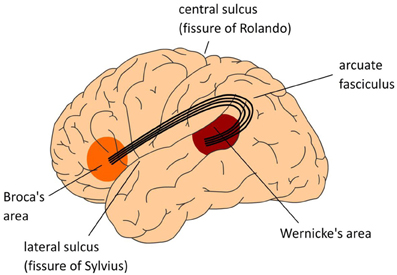Aphasia
Terminology
- Dysarthria = problem with slurring of speech
- Articulation defects = problems with motor control of the mouth
- Anomia = inability to name things, a key finding in almost all aphasias. Mild anomia is difficulty naming objects that are less commonly used in speech. Severe anomia is difficulty naming everyday objects.
- Anosognosia = person is unaware that they have a neurologic deficit, typically due to a lesion in the non-dominant hemisphere
- Apraxia = person is unable to carry out a learned motor task but their motor, sensory and coordination is preserved – so they should be able to perform the task.
- Agnosia = person is unable to recognize objects
- Prosopagnosia = person is unable to recognize faces
- Acalculia = person is unable to calculate
- Aphasia = acquired abnormality of language, usually due to a focal brain lesion. Several types exist and can be distinguished based on whether comprehension, fluency or repetition or a combination of them is affected. Almost all types of aphasia have associated problems with naming (anomia) and with writing — these are used to diagnose an aphasia disorder.

Aphasias
Broca’s aphasia = only comprehension is preserved, both fluency and repetition are impaired — Broca’s Broken speech — mainly “motor”. The person will try to answer the question since they understand well, but they produce a string of nouns that aren’t proper sentences and struggle to find the correct word. Lesion is in Broca’s area i.e. the posterior inferior frontal gyrus of the frontal lobe.
Wernicke’s aphasia = only fluency is preserved with both repetition and comprehension being impaired. This leads to a meaningless string of words – Wernicke’s Word salad. Lesion is in Wernicke’s area i.e. posterior superior temporal gyrus of the temporal lobe.
Conduction aphasia = only repetition is impaired, and both comprehension and fluency are preserved. The lesion is thought to occur in the arcuate fasciculus i.e. the white matter connection between Broca’s area and Wernicke’s area. However, lesions involving the temporal or parietal lobes that spare Wernicke’s area can also lead to conduction aphasia.
Transcortical aphasias spare the arcuate fasciculus and therefore repetition is preserved.
Transcortical motor aphasia = only fluency is impaired and both repetition and comprehension are preserved. Thus, similar to Broca’s but milder with preserved repetition. Lesion is in the anterior superior frontal lobe with sparing of the arcuate fasciculus.
Transcortical sensory aphasia = only comprehension is impaired and both repetition and fluency are preserved. Thus, similar to Wernicke’s but milder with preserved repetition. Lesion is in the inferior temporal lobe with sparing of the arcuate fasciculus.
Global aphasia = everything is impaired – repetition, comprehension and fluency. Lesion typically affects a large area of the brain including both Wernicke’s area and Broca’s area.
| Aphasia | Comprehension | Repetition | Fluency | Lesion |
| Broca’s | preserved | impaired | impaired | posterior inferior frontal gyrus |
| Wernicke’s | impaired | impaired | preserved | posterior superior temporal gyrus |
| Conduction | preserved | impaired | preserved | arcuate fasciculus |
| Global | impaired | impaired | impaired | both wernicke’s and broca’s areas |
| Transcortical motor | preserved | preserved | impaired | anterior superior frontal lobe |
| Transcortical sensory | impaired | preserved | preserved | inferior temporal lobe |
Alexia without agraphia (aka pure alexia) = impaired reading but preserved writing. Lesion in the dominant occipital lobe and splenium of the corpus callosum.
